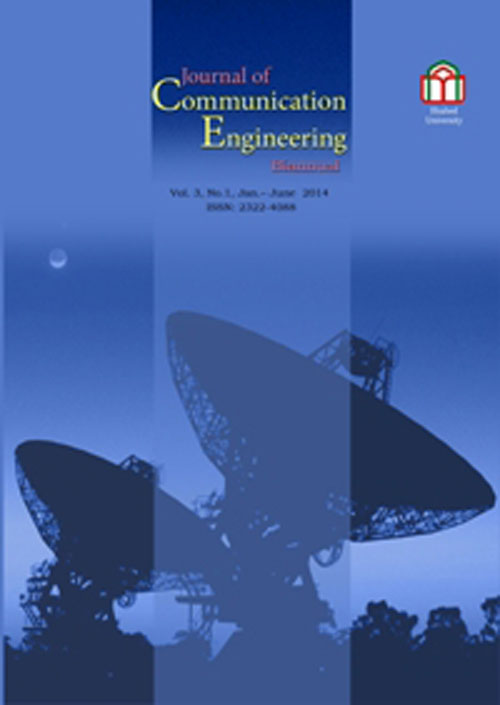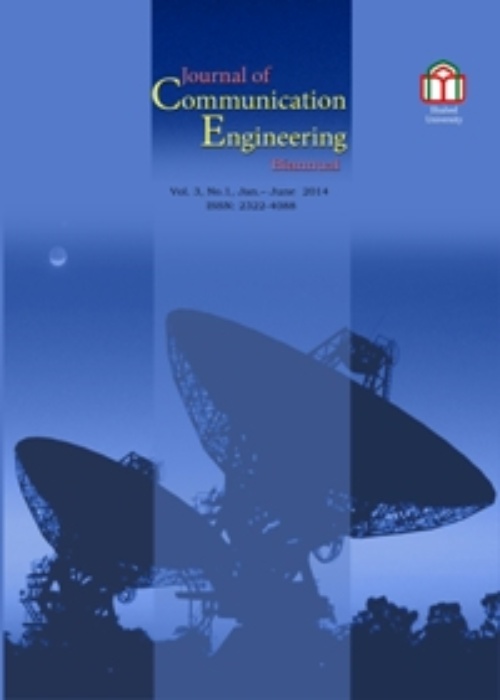فهرست مطالب

Journal of Communication Engineering
Volume:8 Issue: 2, Summer and Autumn 2019
- تاریخ انتشار: 1399/03/11
- تعداد عناوین: 12
-
-
Pages 158-178
Design and simulation of a very small size 6-bit DMTL phase shifter is presented. The idea is based on using both capacitor and resonator type methods simultaneously in a phase shifter. The capacitor section creates less significant bits. The bits in this section start from the least significant bit, with 5.625-degree steps. The resonator section creates the bits with 90-degree steps. CPW transmission line is used as an impedance matching between two type phase shifters. The structure is calculated and simulated at the Ka-band using MATLAB and HFSS softwares, respectively. The proposed method decreases the number of cells, considerably. As a result, the size and loss is decreased. The design can be easily scaled to other frequencies for satellite and radar systems.
Keywords: Phase shifter, Small Size, Capacitor, Resonator, Ka Band -
Pages 179-196
Wireless network-on-chip (WiNoC) is considered as a novel approach for designing future multi-core systems. In WiNoCs, wireless routers (WRs) utilize high-bandwidth wireless links to reduce the transmission delay between the long distance nodes. When the network traffic loads increase, a large number of packets will be sent into the wired and wireless links and can easily fill FIFO queues at the input ports of routers. In these conditions, head-of-line (HOL) blocking and node congestion may occur and the network communications efficiency tremendously decreases. In this study, a low-latency router was proposed, which employs virtual output queuing (VOQ) and bypass channels to eliminate the congestion of routers and improves network performance. Synthetic traffic patterns were simulated using Noxim simulator and obtained results show that considerable improvement in the latency, total energy consumption and the saturation throughput can be achieved compared to the other WiNoCs.
Keywords: wireless network-on-chip, head-of-line blocking, bypass channels, virtual output queuing, low-latency routers -
Pages 197-207
In this paper, the effect of ocean-land mixed propagation path on the lightning performance of grounding rods is investigated. This effect is focused on two problems. The first is extracting exact equivalent circuit of grounding rods in the presence of oceans. The equivalent circuit can be used in transient analysis of power systems in the neighboring oceans. In the second one, this effect on the grounding potential rise (GPR) is investigated. Using the obtained GPRs, the effective length of vertical rods under such an effect can be easily investigated. The simulation results show that for grounding rods far from the ocean, i.e. greater than 15 m, such an effect can be disregarded.
Keywords: Ocean-land mixed path, equivalent circuit, and grounding potential rise -
Pages 208-223
Due to the increasing use of wireless communications, infrastructure-less networks such as Delay Tolerant Networks (DTNs) should be highly considered. DTN is most suitable where there is an intermittent connection between communicating nodes such as wireless mobile ad hoc network nodes. In general, a message sending node in DTN copies the message and transmits it to nodes which it encounters. A receiving node, if it is not the destination of the message, stores the message and transmits a copy of the message to nodes it meets. This process continues until the message reaches its destination or its lifetime expires. Various DTN routing protocols have been proposed to reduce the number of copies and improve the message delivery probability. However, very few of them consider the energy constraint of mobile nodes in routing protocols. Mobile nodes especially smartphones and tablets are powered by batteries with limited energy. It is essential to consider energy constraint while designing routing protocols for DTNs. Moreover, most studies focus on homogeneous networks having nodes with equal transmission radii. At this paper, a probabilistic epidemic (p-epidemic) forwarding scheme is suggested which aims to improve both the energy consumption and the message delivery probability within the heterogeneous sets of nodes. The nodes have two different amounts of available energies and two different transmission radii. Based on this proposed p-epidemic method, the transmission radius and the transmission probability of each node are chosen according to its current energy. The performance of the method is evaluated through many simulations.
Keywords: Delay Tolerant Networks, Node Current Energy, Probabilistic Epidemic Forwarding, Transmission Probability -
Pages 224-233
Proof of concept of a cavity backed slot antenna based on inverted microstrip gap waveguide (IMGW) technology is presented. Since the antenna is operating based on the first resonating mode of the cavity, it is more compact compared to the ordinary cavity backed slot antennas in which the second cavity mode is used for radiation. Furthermore, the proposed antenna element introduces lower losses compared to a microstrip patch thanks to the surface wave suppression and lower dielectric loss of the air filled IMGW cavity. A sample antenna is designed and fabricated to operate at 9.6GHz and quite good agreement between simulation and measurement results is observed.
Keywords: cavity backed, compact, gap waveguide, microstrip, slot antenna -
Pages 234-248
Merging the adaptive networks with the free space optical (FSO) communication technology is a very interesting field of research because by adding the benefits of this technology, the adaptive networks become more efficient, cheap and secure. This is due to the fact that FSO communication uses unregistered visible light bandwidth instead of the overused radio spectrum. However, in spite of all the benefits of FSO communication, this technology suffers from optical noise and turbulence. In this paper, we investigate the exact effect of the negative exponential and k-distribution modeled very strong turbulence conditions on the performance of diffusion adaptive networks. The simulation and theoretical results based on the steady state Mean square deviation (MSD) and Excess mean square Error (EMSE) vlaues show the deteriorating effects of these link models on diffusion networks. The FSO communication technology, while very profitable and applicable, is not always a suitable means of implementing wireless networks. For this reason, we suggested the channel estimation for these conditions.
Keywords: Log-normal distribution, Turbulence, Negative-exponential, K-distribution, FSO, distributed diffusion networks -
Pages 249-265
Energy constraint is the biggest challenge in wireless sensor networks because the power supply of each sensor node is a battery that is not rechargeable or replaceable due to the applications of these networks. One of the successful methods for saving energy in these networks is clustering. It has caused that cluster-based routing algorithms are successful routing algorithm for these networks. In this paper, a new routing algorithm based on a hierarchical clustering is proposed for these networks. In each level of this hierarchical clustering, the appropriate nodes are selected as cluster heads and then formed the clusters. The proposed algorithm is distributed and selects cluster heads and forms the clusters with the smallest number of the control messages. Moreover, while clustering is performed, an efficient routing among cluster heads towards the sink is created which does not need sending any more control messages in the network. Simulation results show that the proposed algorithm has better performance than other similar algorithms.
Keywords: Clustering, Energy Consumption, Wireless Sensor Network -
Pages 266-276
A new multi-layer substrate integrated waveguide (SIW) structure is developed to design dual-band evanescent-mode band-pass filters (BPFs). Two independent series LC circuits are implemented by incorporating metallic irises in the different layers of the structure. The combination of the metallic irises with capacitive-plates is embedded inside the SIW to independently excite two evanescent-mode resonance frequencies below the cut-off frequency of the structure. Two integrated series irises and capacitive-plates are incorporated in an antipodal configuration to minimize the coupling interference between them. A dual-band evanescent-mode band-pass filter is designed and characterized at 2.4GHz and 5.8GHz frequencies for Wireless Local Area Network (WLAN). The first resonance frequency of the filter is fixed at 2.4GHz (2400-2484MHz) and the second one is tuned at 5.2GHz (5150-5350MHz) to partially meet the standard IEEE 802.11 WLAN bandwidths and fully meet the WLAN frequencies. This approach demonstrates the miniaturized dual-band high quality- factor evanescent-mode band-pass filter. The structure is designed and simulated by taking into account of all fabrication aspects.
Keywords: Band-pass filter (BPF), capacitive-plate, evanescent-mode, substrate integrated waveguide (SIW), wireless local area network (WLAN) -
Pages 277-289
A new hybrid-model for BCI probe is derived . This model is built based on the probe's internal structure without refinements, and by carrying out just one electrical measurement for the reflection coefficient, so that it can be generalized and used in studying the effect of layout parameters in the aim of improving the probe high frequency performance, which helps the developer in design stage. The hybrid-model is validated versus extracted permeability spectra, voltage transfer ratio and series impedance for the probe F-130A. The comparison is made between the derived hybrid-model and that of explicit model, the results showed a good accordance between them. An application for the model is illustrated to bring to light its effectiveness.
Keywords: Bulk current injection (BCI), complex permeability spectra, electromagnetic Compatibility (EMC), modeling, transmission line (TL) -
Pages 290-303Channel estimation in communication systems is one of the most important issues that can reduce the error rate of sending and receiving information as much as possible. In this regard, estimation of OFDM-based wireless channels using known sub-carriers as pilot is of particular importance in frequency domain. In this paper, channel estimation under short cyclic prefix (CP) in OFDM system is considered. An adaptive algorithm based on the set-membership filtering algorithm is used to compensate for this problem. In short CP length, the per-tone equalization (PTEQ) structure is used to prevent inter-symbol interference (ISI). This structure has high computational complexity, so using the set-membership filtering idea with variable step size while reducing the average computation of the system can also increase the convergence speed of the estimates. On the other hand, utilizing the wavelet transform on the branch of this structure in each sub-carrier before applying adaptive filters will in turn increase the estimation speed. The simulation results show better performance than conventional adaptive algorithms. In addition, the estimation and compensation of the channel effect under short CP can be easily accomplished by this algorithm.Keywords: Channel estimation, PTEQ structure, Set-membership filtering, Short CP, Wavelet packet transform
-
Pages 304-312An outstanding square slot element, for x-band wireless applications with asymmetric coplanar waveguide fed (CPW) is proposed. Various shapes of metallic strips are utilized as grounded stubs for providing Right Hand Circular Polarization (RHCP) functionality and wide-band properties. By adjusting the proposed stubs and hook-shaped radiator, length and positions, wider impedance band width is obtained in x-band. In addition, asymmetric feeding technique is employed with semi-hook shaped radiating patch for efficient impedance matching and generating new resonances. By using rectangular slot and semi-hook shaped radiator good impedance matching is achieved in frequency band. Besides that, by introducing strips in ground plane, RHCP is achieved in x-band. The antenna size is only about 25×25×1 mm3, which covers the band from 6.5-12.9 GHz for S11Keywords: Element circularly polarized, Left Hand, Right hand, Wide-band
-
Pages 313-324This paper aims at investigating the superiority of power allocation strategies, based on calculus of variations in a point-to-point two-way relay-assisted channel incorporating the amplify and forward strategy. Single and multilayer coding strategies for two cases of having and not having the channel state information (CSI) at the transmitters are studied, respectively. Using the notion of calculus of variations, the optimum power allocation strategy across code layers for the case of employing Multilayer coding is derived and is shown to surpass the conventional outage approach employing single layer coding strategy in terms of the achievable sum rate of the network. Moreover, for the case of knowing the CSI at the transmitters, an adaptive power control strategy is analytically derived, and its achievable sum-rate is compared to that of the single-layer strategy under peak power constraint.Keywords: Multi-layer Coding, calculus of variation, Power Allocation


